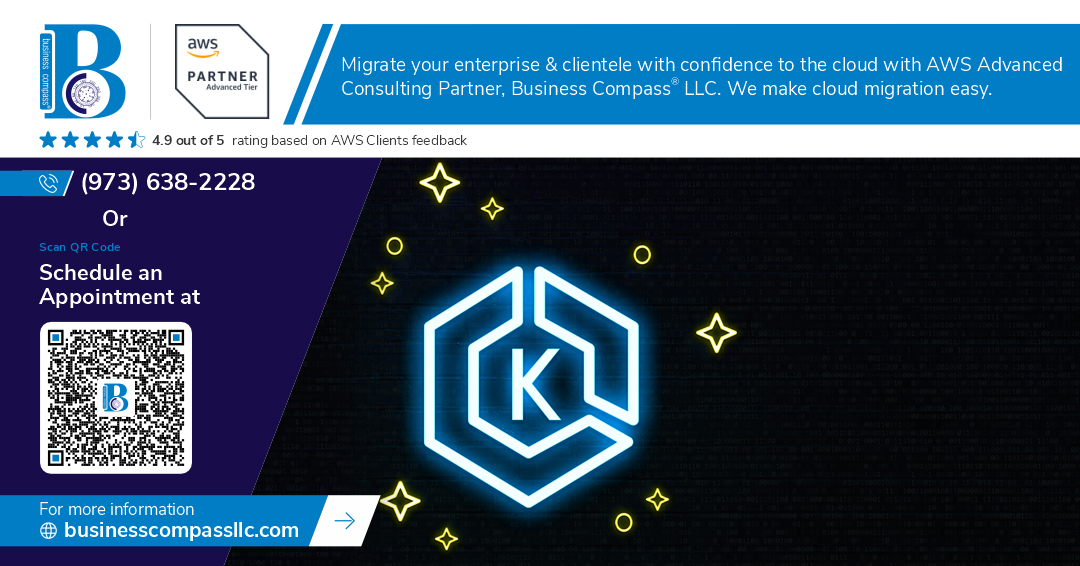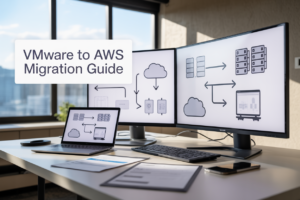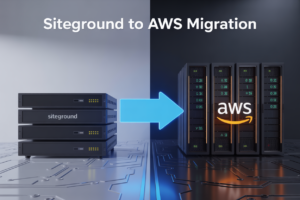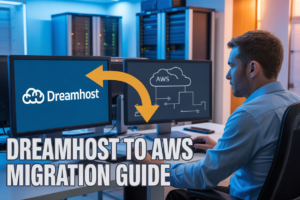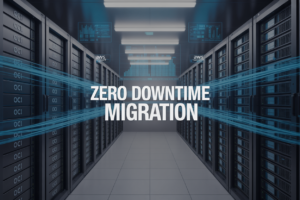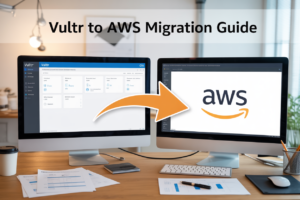Managing Kubernetes clusters manually gets old fast, especially when you’re running production workloads that need consistent, reliable infrastructure. Automate EKS cluster deployment with Terraform and you’ll save hours of repetitive work while reducing human error.
This guide is for DevOps engineers, cloud architects, and platform teams who want to build production EKS cluster setup using infrastructure as code. You’ll learn how to create repeatable, scalable AWS EKS Terraform configurations that your team can trust in production.
We’ll walk through the essential Terraform configuration structure for EKS, covering everything from basic cluster setup to advanced networking and security configurations. You’ll also discover AWS EKS cost optimization Terraform strategies that can significantly reduce your monthly cloud bill. Finally, we’ll set up an automated deployment pipeline so your Kubernetes cluster automation Terraform runs smoothly every time.
By the end, you’ll have a complete terraform EKS cluster automation workflow that handles production workloads with confidence.
Prerequisites and Environment Setup for EKS Automation
Install and Configure AWS CLI with Proper Credentials
Download and install the latest AWS CLI version from the official AWS website. Run aws configure to set your access key ID, secret access key, default region, and output format. For production environments, use IAM roles with temporary credentials rather than long-term access keys. Verify your setup with aws sts get-caller-identity to confirm proper authentication and permissions.
Set up Terraform with Required Providers and Versions
Create a versions.tf file specifying Terraform version constraints and required providers. Pin the AWS provider to a specific version for consistency across deployments. Initialize your workspace with terraform init to download necessary provider plugins. Configure a remote backend like S3 for state management with DynamoDB for state locking to enable team collaboration and prevent concurrent modifications.
Configure kubectl for Cluster Management
Install kubectl matching your target Kubernetes version for compatibility. After cluster creation, update your kubeconfig with aws eks update-kubeconfig --region your-region --name cluster-name. Test connectivity using kubectl cluster-info and kubectl get nodes. Store kubeconfig securely and consider using different contexts for multiple clusters to avoid accidental operations on wrong environments.
Establish Proper IAM Roles and Permissions
Create dedicated IAM roles for EKS cluster service and node groups with AWS-managed policies like AmazonEKSClusterPolicy and AmazonEKSWorkerNodePolicy. Set up OIDC identity provider for service account authentication. Implement least-privilege access using custom policies for specific workload requirements. Document role assignments and regularly audit permissions to maintain security posture while enabling necessary cluster operations.
Essential Terraform Configuration Structure for EKS
Create Modular Directory Structure for Scalable Infrastructure
Organizing your Terraform EKS cluster automation starts with a clean directory structure that separates concerns and promotes reusability. Create distinct modules for networking, security groups, EKS cluster, and node groups to enable independent testing and deployment. Structure your project with root-level environments (dev, staging, prod) that reference shared modules, allowing consistent infrastructure patterns across all deployment stages while maintaining environment-specific configurations.
terraform-eks/
├── modules/
│ ├── vpc/
│ ├── security-groups/
│ ├── eks-cluster/
│ └── node-groups/
├── environments/
│ ├── dev/
│ ├── staging/
│ └── prod/
└── shared/
Define Variables and Outputs for Flexible Deployment
Build flexible terraform kubernetes aws deployments by defining comprehensive variables that cover cluster sizing, networking, and security configurations. Create input variables for node instance types, scaling parameters, subnet CIDRs, and security policies to support different production eks cluster setup requirements. Design outputs that expose essential cluster information like endpoint URLs, security group IDs, and IAM role ARNs for integration with other infrastructure components or CI/CD pipelines.
Key Variable Categories:
- Cluster configuration (name, version, endpoint access)
- Node group settings (instance types, scaling limits, AMI types)
- Network parameters (VPC CIDRs, availability zones, subnet configurations)
- Security settings (encryption keys, IAM roles, security group rules)
Configure Provider Settings and Backend State Management
Configure the AWS provider with proper versioning constraints and authentication settings for reliable eks infrastructure as code deployments. Set up remote state storage using S3 with DynamoDB locking to prevent concurrent modifications and ensure state consistency across team members. Enable state encryption and versioning to protect sensitive cluster data and provide rollback capabilities during infrastructure changes.
Backend Configuration Example:
terraform {
backend "s3" {
bucket = "your-terraform-state-bucket"
key = "eks/terraform.tfstate"
region = "us-west-2"
encrypt = true
dynamodb_table = "terraform-locks"
}
}
Building Production-Ready EKS Cluster Infrastructure
Define VPC and networking components with proper subnets
Creating a robust network foundation requires careful VPC design with public and private subnets across multiple availability zones. Your Terraform eks cluster automation should include at least two private subnets for worker nodes and two public subnets for load balancers. Configure route tables to direct private subnet traffic through NAT gateways while maintaining internet connectivity for essential services. Enable VPC flow logs and DNS hostname resolution to support proper pod networking and service discovery within your production eks cluster setup.
Configure EKS cluster with optimal node groups and scaling
Design your aws eks terraform production configuration with managed node groups that scale based on workload demands. Set minimum, maximum, and desired capacity values that align with your application requirements. Choose instance types that balance cost and performance – typically m5.large or m5.xlarge for general workloads. Configure spot instances alongside on-demand nodes to optimize costs while maintaining reliability. Enable cluster autoscaler and configure pod disruption budgets to handle scaling events gracefully without service interruption.
Set up security groups and network policies for isolation
Implement defense-in-depth security through carefully crafted security groups and Kubernetes network policies. Create separate security groups for control plane, worker nodes, and application load balancers with minimal required permissions. Configure ingress rules to allow only necessary traffic between components. Use Kubernetes network policies to isolate namespaces and restrict pod-to-pod communication. Enable private endpoint access for the EKS API server to prevent unauthorized external access while maintaining kubectl functionality from bastion hosts or CI/CD systems.
Implement logging and monitoring capabilities
Enable comprehensive logging through CloudWatch Container Insights and EKS control plane logging for all five log types: api, audit, authenticator, controllerManager, and scheduler. Configure Fluent Bit or CloudWatch agent to collect application logs and system metrics. Set up CloudWatch alarms for critical metrics like CPU utilization, memory consumption, and pod restart counts. Integrate AWS X-Ray for distributed tracing and implement custom metrics dashboards to monitor application performance and infrastructure health across your kubernetes cluster automation terraform setup.
Configure storage classes and persistent volume support
Define multiple storage classes to support diverse application requirements using EBS CSI driver with GP3 volumes for optimal cost-performance balance. Create storage classes for different use cases: fast SSD storage for databases, standard storage for general applications, and backup storage for archival needs. Configure volume expansion capabilities and backup policies through AWS Backup. Implement proper RBAC permissions for persistent volume provisioning and ensure storage encryption at rest using AWS KMS keys for compliance requirements.
Advanced Security and Compliance Configuration
Enable cluster encryption and secure API endpoint access
Configure encryption at rest for EKS using AWS KMS keys in your terraform eks cluster automation setup. Enable envelope encryption for etcd data and ensure API server endpoint access remains private through VPC configuration. Set up security groups that restrict access to specific IP ranges and implement VPC endpoint policies for enhanced network isolation.
resource "aws_kms_key" "eks_encryption" {
description = "EKS encryption key"
policy = jsonencode({
Statement = [{
Effect = "Allow"
Principal = { AWS = "arn:aws:iam::${data.aws_caller_identity.current.account_id}:root" }
Action = "kms:*"
Resource = "*"
}]
})
}
resource "aws_eks_cluster" "production" {
encryption_config {
resources = ["secrets"]
provider {
key_arn = aws_kms_key.eks_encryption.arn
}
}
vpc_config {
endpoint_private_access = true
endpoint_public_access = false
subnet_ids = var.private_subnet_ids
}
}
Implement pod security standards and network policies
Deploy Kubernetes network policies and pod security standards through Terraform to enforce runtime security. Configure Calico or AWS VPC CNI for network segmentation and create admission controllers that validate pod specifications against security baselines.
resource "kubernetes_network_policy" "deny_all" {
metadata {
name = "deny-all-traffic"
namespace = "production"
}
spec {
pod_selector {}
policy_types = ["Ingress", "Egress"]
}
}
resource "kubernetes_manifest" "pod_security_policy" {
manifest = {
apiVersion = "policy/v1beta1"
kind = "PodSecurityPolicy"
metadata = { name = "restricted" }
spec = {
privileged = false
allowPrivilegeEscalation = false
requiredDropCapabilities = ["ALL"]
runAsUser = { rule = "MustRunAsNonRoot" }
}
}
}
Configure RBAC and service account management
Set up granular role-based access control using Terraform kubernetes provider for production eks cluster setup. Create service accounts with minimal permissions and bind them to specific roles that align with workload requirements. Implement AWS IAM roles for service accounts (IRSA) to provide fine-grained access to AWS services.
resource "kubernetes_service_account" "app_service_account" {
metadata {
name = "app-service-account"
namespace = "production"
annotations = {
"eks.amazonaws.com/role-arn" = aws_iam_role.app_role.arn
}
}
}
resource "kubernetes_role_binding" "app_binding" {
metadata {
name = "app-role-binding"
namespace = "production"
}
role_ref {
api_group = "rbac.authorization.k8s.io"
kind = "Role"
name = "app-role"
}
subject {
kind = "ServiceAccount"
name = kubernetes_service_account.app_service_account.metadata[0].name
namespace = "production"
}
}
Set up secrets management with AWS Secrets Manager integration
Integrate AWS Secrets Manager with your EKS terraform security configuration using the Secrets Store CSI driver. Create external secrets operators that automatically sync sensitive data from AWS services into Kubernetes secrets, ensuring credentials rotate automatically and remain encrypted in transit.
resource "helm_release" "secrets_store_csi" {
name = "secrets-store-csi-driver"
repository = "https://kubernetes-sigs.github.io/secrets-store-csi-driver/charts"
chart = "secrets-store-csi-driver"
namespace = "kube-system"
values = [
yamlencode({
syncSecret = { enabled = true }
enableSecretRotation = true
})
]
}
resource "kubernetes_manifest" "secret_provider_class" {
manifest = {
apiVersion = "secrets-store.csi.x-k8s.io/v1"
kind = "SecretProviderClass"
metadata = {
name = "app-secrets"
namespace = "production"
}
spec = {
provider = "aws"
parameters = {
objects = yamlencode([
objectName = "prod/app/database"
objectType = "secretsmanager"
}])
}
}
}
}
Automated Deployment Pipeline and Best Practices
Create Reusable Terraform Modules for Different Environments
Building modular Terraform configurations transforms your aws eks terraform production workflow into a scalable, maintainable system. Start by creating a base EKS module that encapsulates core cluster components like node groups, networking, and security configurations. Structure your modules with clear input variables for environment-specific parameters such as instance types, scaling configurations, and RBAC policies.
Organize your terraform eks cluster automation modules using a hierarchical approach where shared resources live in common modules while environment-specific customizations exist in dedicated directories. Create separate modules for development, staging, and production environments that inherit from your base configuration but override specific parameters like cluster size, storage classes, and monitoring settings.
Use Terraform workspaces or separate state files for each environment to prevent accidental cross-environment changes. Version your modules using Git tags and semantic versioning to track changes and enable rollbacks. This modular approach reduces code duplication and ensures consistent deployments across all environments while maintaining flexibility for environment-specific requirements.
Implement CI/CD Integration with Proper Testing Stages
Modern eks infrastructure as code demands robust CI/CD pipelines that validate, test, and deploy your Terraform configurations safely. Set up automated validation stages that check Terraform syntax, run security scans using tools like Checkov or tfsec, and validate resource configurations against company policies using Open Policy Agent.
Create multi-stage pipeline workflows that progress through validation, planning, and deployment phases. Implement terraform plan outputs as pull request comments so team members can review infrastructure changes before merging. Use automated testing frameworks like Terratest to verify that deployed resources meet functional requirements and security standards.
Configure branch protection rules that require successful pipeline execution before merging changes to main branches. Implement drift detection mechanisms that regularly compare your actual AWS infrastructure against your Terraform state files and alert on any discrepancies. This ensures your production eks cluster setup remains consistent with your declared infrastructure as code definitions.
Set up Automated Backup and Disaster Recovery Procedures
Production kubernetes cluster automation terraform requires comprehensive backup strategies that protect both cluster state and application data. Implement automated ETCD backups using AWS EKS built-in backup mechanisms or third-party solutions like Velero for complete cluster state preservation. Schedule regular backups of persistent volumes, secrets, and configuration maps to ensure complete data protection.
Create disaster recovery playbooks that automate cluster restoration procedures using your terraform kubernetes aws configurations. Test your recovery procedures regularly by spinning up clusters in isolated environments using your backup data. Document recovery time objectives (RTO) and recovery point objectives (RPO) to meet business requirements.
Set up cross-region replication for critical data and maintain Terraform state files in versioned S3 buckets with cross-region replication enabled. Implement monitoring and alerting systems that track backup success rates and automatically trigger recovery procedures when failures are detected. Regular disaster recovery drills ensure your team can quickly restore services during actual outages.
Cost Optimization and Performance Tuning
Configure spot instances and right-sizing strategies
Spot instances can slash your aws eks cost optimization terraform expenses by up to 90% for non-critical workloads. Configure mixed instance types in your node groups using Terraform’s aws_eks_node_group resource with spot capacity. Set up instance diversification across multiple availability zones and instance families to reduce interruption risks. Right-size your nodes by analyzing actual resource consumption patterns and adjusting instance types accordingly. Use the capacity_type = "SPOT" parameter in your Terraform configuration and implement proper pod disruption budgets to handle spot terminations gracefully.
Implement cluster autoscaling and resource management
The Cluster Autoscaler automatically adjusts node count based on pod scheduling requirements, optimizing both cost and performance for your terraform eks cluster automation. Deploy the autoscaler using Terraform with proper IAM roles and policies. Configure horizontal pod autoscaling (HPA) and vertical pod autoscaling (VPA) to handle application-level scaling. Set appropriate --scale-down-delay-after-add and --scale-down-unneeded-time parameters to prevent thrashing. Use node affinity and anti-affinity rules to optimize pod placement and resource distribution across your cluster infrastructure.
Monitor and optimize compute and storage costs
Implement comprehensive cost monitoring using AWS Cost Explorer integration with your eks infrastructure as code setup. Set up CloudWatch metrics for cluster resource utilization and create custom dashboards for cost tracking. Use AWS Trusted Advisor recommendations to identify underutilized resources. Configure storage class optimization by implementing gp3 volumes instead of gp2, and set up automated EBS volume resizing. Deploy tools like KubeCost or AWS Container Insights to get granular visibility into per-pod and per-namespace resource consumption patterns.
Set up resource quotas and limits for efficient utilization
Resource quotas prevent individual namespaces from consuming excessive cluster resources in your production eks cluster setup. Define memory and CPU limits at both container and namespace levels using Terraform kubernetes provider. Implement LimitRange objects to set default resource requests and limits for pods. Configure priority classes to ensure critical workloads get scheduled first during resource constraints. Use admission controllers like ResourceQuota and LimitRanger to enforce policies automatically. Set up monitoring alerts when namespaces approach their quota limits to proactively manage resource allocation.
Managing EKS clusters manually can quickly become overwhelming, especially when you’re dealing with production workloads that demand consistency and reliability. Terraform gives you the power to automate everything from the initial cluster setup to advanced security configurations, all while keeping your infrastructure code organized and version-controlled. The combination of proper environment setup, well-structured Terraform modules, and automated pipelines creates a solid foundation that scales with your team and business needs.
The real game-changer comes from treating your EKS infrastructure as code rather than a collection of manual tasks. When you build in security best practices, cost optimization strategies, and performance tuning from day one, you’re setting yourself up for long-term success. Start small with a basic cluster configuration, then gradually add the advanced features like automated compliance checks and deployment pipelines. Your future self will thank you for taking the time to automate these processes properly – and your team will love having reliable, repeatable deployments they can trust.










